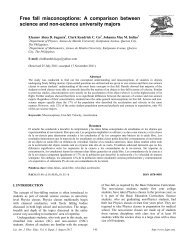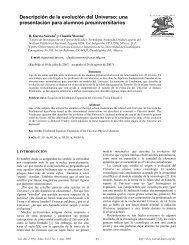A brief history of the mathematical equivalence between the two ...
A brief history of the mathematical equivalence between the two ...
A brief history of the mathematical equivalence between the two ...
You also want an ePaper? Increase the reach of your titles
YUMPU automatically turns print PDFs into web optimized ePapers that Google loves.
A <strong>brief</strong> <strong>history</strong> <strong>of</strong> <strong>the</strong> ma<strong>the</strong>matical <strong>equivalence</strong><strong>between</strong> <strong>the</strong> <strong>two</strong> quantum mechanicsCarlos M. Madrid Casado 1, 21 Departamento de Matemáticas, IES Lázaro Cárdenas, Collado Villalba, Madrid, España.2 Departamento de Lógica y Filos<strong>of</strong>ía de la Ciencia, Facultad de Filos<strong>of</strong>ía, UniversidadComplutense, Madrid, España.E-mail: carlos.madrid@educa.madrid.org(Received 29 December 2007; aceppted 4 March 2008)AbstractThe aim <strong>of</strong> this paper is to give a <strong>brief</strong> account <strong>of</strong> <strong>the</strong> development <strong>of</strong> <strong>the</strong> ma<strong>the</strong>matical <strong>equivalence</strong> <strong>of</strong> quantummechanics. In order to deal with atomic systems, Heisenberg developed matrix mechanics in 1925. Some time later, in<strong>the</strong> winter <strong>of</strong> 1926, Schrödinger established his wave mechanics. In <strong>the</strong> spring <strong>of</strong> 1926, quantum physicists had <strong>two</strong><strong>the</strong>oretical models that allowed <strong>the</strong>m to predict <strong>the</strong> same behaviour <strong>of</strong> <strong>the</strong> quantum systems, but both <strong>of</strong> <strong>the</strong>m werevery different. Schrödinger thought that <strong>the</strong> empirical <strong>equivalence</strong> could be explained by means <strong>of</strong> a pro<strong>of</strong> <strong>of</strong>ma<strong>the</strong>matical <strong>equivalence</strong>.Keywords: Matrix mechanics, wave mechanics, ma<strong>the</strong>matical <strong>equivalence</strong>.ResumenEl objetivo de este artículo es <strong>of</strong>recer una breve reseña del desarrollo de la equivalencia matemática de las mecánicascuánticas. Para tratar con los sistemas atómicos, Heisenberg desarrolló la mecánica matricial en 1925. Algún tiempodespués, en el invierno de 1926, Schrödinger estableció su mecánica ondulatoria. En la primavera de 1926, los físicoscuánticos disponían de dos modelos teóricos que les permitían predecir el mismo comportamiento de los sistemascuánticos, pero ambos eran muy diferentes. Schrödinger pensó que la equivalencia empírica podría ser explicadamediante una prueba de equivalencia matemática.Palabras clave: Mecánica matricial, mecánica ondulatoria, equivalencia matemática.PACS: 01.65.+g, 01.70.+w, 03.65.Ca. ISSN 1870-9095I. INTRODUCTIONQuantum physics grew out from attempts to understand <strong>the</strong>strange behaviour <strong>of</strong> atomic systems, which were capable<strong>of</strong> assuming discrete energy changes only. The heroicorigin <strong>of</strong> quantum <strong>the</strong>ory dates from December 14 th , 1900.The dramatis personae <strong>of</strong> <strong>the</strong> pre<strong>history</strong> <strong>of</strong> quantum<strong>the</strong>ory (1900-1924) includes <strong>the</strong> names <strong>of</strong> Max Planck,Albert Einstein or Niels Bohr. However, old quantumphysics was a bridge over troubled waters: each problemhad to be solved first within <strong>the</strong> classical physics realm,and only <strong>the</strong>n <strong>the</strong> solution could be translated –by means<strong>of</strong> diverse computation rules (for instance: <strong>the</strong>Correspondence Principle <strong>of</strong> Bohr)– into a meaningfulstatement in quantum physics. These rules revealed adismaying state <strong>of</strong> affairs in 1924. In words <strong>of</strong> Bohr,Kramers & Slater [1]:“At <strong>the</strong> present state <strong>of</strong> science it does notseem possible to avoid <strong>the</strong> formal character <strong>of</strong><strong>the</strong> quantum <strong>the</strong>ory which is shown by <strong>the</strong>fact that <strong>the</strong> interpretation <strong>of</strong> atomicphenomena does not involve a description <strong>of</strong><strong>the</strong> mechanism <strong>of</strong> <strong>the</strong> discontinuousprocesses, which in <strong>the</strong> quantum <strong>the</strong>ory <strong>of</strong>spectra are designated as transitions <strong>between</strong>stationary states <strong>of</strong> <strong>the</strong> atom.”Quantum physicists became more and more convinced thata radical change on <strong>the</strong> foundations <strong>of</strong> physics wasnecessary, that is to say: a new kind <strong>of</strong> mechanics which<strong>the</strong>y called quantum mechanics.II. MATRIX MECHANICSIn 1925 Werner Heisenberg developed matrix mechanics(MM) in his paper Über quanten<strong>the</strong>oretische Umdeutungkinematischer und mechanischer Beziehungen [2],although he did not even know what a matrix was, as MaxBorn and Pascual Jordan pointed out.Heisenberg aimed at constructing a quantummechanicalformalism corresponding as closely as possibleto that <strong>of</strong> classical mechanics. Thus he considered <strong>the</strong>classical equation <strong>of</strong> motionLat. Am. J. Phys. Educ. Vol. 2, No. 2, May 2008 152 http://www.journal.lapen.org.mx
where he substituted x and f (x)by <strong>the</strong>ir quantumanalogues. The classical position q and momentum p (and<strong>the</strong>ir operations q 2 , p 2 , pq...) were assigned <strong>the</strong> quantumposition Q and <strong>the</strong> quantum moment P (and, respectively,<strong>the</strong>ir operations Q 2 , P 2 , PQ...), where Q and P werematrices completely determined by <strong>the</strong> intensity andfrequency <strong>of</strong> <strong>the</strong> emitted or absorbed atomic radiation.These matrices satisfied <strong>the</strong> so-called ‘exact quantumcondition’This equation was <strong>the</strong> only one <strong>of</strong> <strong>the</strong> formulae in quantummechanics proposed by Heisenberg, Born & Jordan whichcontained Planck’s constant h. Finally, a variationalprinciple, derived from correspondence considerations,yielded certain motion equations for a general HamiltonianH, which was a close analogue <strong>of</strong> <strong>the</strong> classical canonicalequationsQ ∂H= ; ∂ PHP ∂= − . (3)∂QConsequently, <strong>the</strong> basic matrix-mechanical problem wasmerely that <strong>of</strong> integrating <strong>the</strong>se motion equations, i. e. <strong>the</strong>algebraic problem <strong>of</strong> diagonalizing <strong>the</strong> Hamiltonianmatrix, whose eigenvalues were <strong>the</strong> quantum energylevels.III. WAVE MECHANICSIn <strong>the</strong> winter <strong>of</strong> 1926 Erwin Schrödinger established hisWellenmechanik [3, 4]. The fundamental idea <strong>of</strong> wavemechanics (WM) was that <strong>the</strong> quantum phenomena had tobe described adequately by specifying a definite wavefunction ψ . The wave equation that replaced <strong>the</strong> classicalequation <strong>of</strong> motion was Schrödinger’s equation:H~ψ = Eψ , (4)where H ~ is <strong>the</strong> operator obtained by substitution <strong>of</strong> q andp in <strong>the</strong> classical Hamiltonian by <strong>the</strong> operatorsandA <strong>brief</strong> <strong>history</strong> <strong>of</strong> <strong>the</strong> ma<strong>the</strong>matical <strong>equivalence</strong> <strong>between</strong> <strong>the</strong> <strong>two</strong> quantum mechanics x = f (x) , (1) solving this partial differential equation. The eigenvaluesE n were, according to Schrödinger, <strong>the</strong> quantum energylevels.However one month before Schrödinger published hisfamous equation (4), <strong>the</strong> Hungarian physicist CornelLanczos wrote an integral equation as <strong>the</strong> first nonmatricialversion <strong>of</strong> quantum mechanics [5]. But if wetransform <strong>the</strong> integral equation into a differential one,<strong>the</strong>re results <strong>the</strong> Schrödinger equation (4) for stationarystates [6].Thus in <strong>the</strong> spring <strong>of</strong> 1926 quantum physicists disposed<strong>of</strong> <strong>two</strong> <strong>the</strong>oretical models in order to deal with suchobservable phenomena like <strong>the</strong> electromagnetic emissionhand absorption atomic spectra (quantum spectra). In o<strong>the</strong>rPQ − QP = I . (2)2πiwords, <strong>the</strong>y had <strong>two</strong> different hypo<strong>the</strong>tical reconstructions<strong>of</strong> quantum phenomena for <strong>the</strong> prediction <strong>of</strong> <strong>the</strong> samebehaviour <strong>of</strong> <strong>the</strong> quantum system under investigation. Both<strong>of</strong> <strong>the</strong>m were ma<strong>the</strong>matically different but empiricallyequivalent. How could this fact be accounted for?~Q =x~ ∂P = −i∂x(5). (6)The basic wave-mechanical problem was now that <strong>of</strong>IV. THE MATHEMATICAL EQUIVALENCEBETWEEN MATRIX MECHANICS ANDWAVE MECHANICSSchrödinger thought that <strong>the</strong> empirical <strong>equivalence</strong> couldbe explained by means <strong>of</strong> a pro<strong>of</strong> <strong>of</strong> ma<strong>the</strong>matical<strong>equivalence</strong>. Were he able to prove <strong>the</strong> ma<strong>the</strong>matical<strong>equivalence</strong> <strong>of</strong> MM and WM, <strong>the</strong>n a weaker <strong>equivalence</strong>should also hold: both mechanics would necessarily beempirically equivalent. That was <strong>the</strong> aim <strong>of</strong> his paper Überdas Verhältnis der Heisenberg-Born-JordanschenQuantenmechanik zu der meinen <strong>of</strong> May, 1926 [7]. In hisown words:“Considering <strong>the</strong> extraordinary differences<strong>between</strong> <strong>the</strong> starting-points and <strong>the</strong>concepts <strong>of</strong> Heisenberg’s quantummechanics and <strong>of</strong> <strong>the</strong> <strong>the</strong>ory which hasbeen designated ‘undulatory’ or ‘physical’mechanics, and has lately been describedhere, it is very strange that <strong>the</strong>se <strong>two</strong> new<strong>the</strong>ories agree with one ano<strong>the</strong>r withregard to <strong>the</strong> known facts, where <strong>the</strong>ydiffer from <strong>the</strong> old quantum <strong>the</strong>ory. [...]That is really very remarkable, becausestarting-points, presentations, methods, andin fact <strong>the</strong> whole ma<strong>the</strong>matical apparatus,seem fundamentally different. [...] In whatfollows <strong>the</strong> very intimate inner connection<strong>between</strong> Heisenberg’s quantum mechanicsand my wave mechanics will be disclosed.From <strong>the</strong> formal ma<strong>the</strong>matical standpoint,one might well speak <strong>of</strong> <strong>the</strong> identity <strong>of</strong> <strong>the</strong><strong>two</strong> <strong>the</strong>ories.”However Schrödinger was not able to establish <strong>the</strong>ma<strong>the</strong>matical <strong>equivalence</strong> <strong>between</strong> WM and MM due toconceptual and technical difficulties [8, 9, 10, 11]. He didLat. Am. J. Phys. Educ. Vol. 2, No. 2, May 2008 153 http://www.journal.lapen.org.mx
Carlos M. Madrid Casadoprove indeed that WM is contained in MM, but not <strong>the</strong>reciprocal, and this is a serious flaw. To be precise: givenan arbitrary complete orthonormal system <strong>of</strong> proper wavefunctions { ϕ k }, Schrödinger was able to show that eachoperator F ~ <strong>of</strong> WM could be related to a matrix F <strong>of</strong> MMin <strong>the</strong> following way:Θ { ϕ k }: { Operators <strong>of</strong> WM } → { Matrices <strong>of</strong> MM },⎛ F11F12 ⎞⎜⎟~ ⎜ F21 ⎟F F = ⎜ F ⎟ =⎜mm⎟⎝ ⎠+∞∫−∞* ~= ( F ) = ( ϕ ( x)F(ϕ )( x)dx), (7)mni. e., as Schrödinger [7] claims: “a matrix element iscomputed by multiplying <strong>the</strong> function <strong>of</strong> <strong>the</strong> orthogonalsystem denoted by <strong>the</strong> row-index [...] by <strong>the</strong> result arisingfrom using our operator in <strong>the</strong> orthogonal functioncorresponding to <strong>the</strong> column-index, and <strong>the</strong>n byintegrating <strong>the</strong> whole over <strong>the</strong> domain”. In particular,Schrödinger obtained:and~ Θ+∞∫*mnm−∞Q (Q~ Θ+∞*mn−∞P (Pm) = ( ϕ ( x)xϕ( x)dx)∂) = ( −i∫ϕm( x)ϕn( x)dx)∂xwhere <strong>the</strong> results Q and P satisfy Heisenberg’s formalrules (<strong>the</strong> so called ‘exact quantum condition’). The mainissue here was whe<strong>the</strong>r or not <strong>the</strong> algebraic morphism Θis an isomorphism.Obviously morphism Θ <strong>between</strong> operators in WM andmatrices in MM is not an isomorphism, since everyundulatory operator is assigned a different matrix (thus Θis injective), but not necessarily every matrix in MMcomes from an operator (surjectivity condition). Θ isinjective because “ F ~ is fixed uniquely by <strong>the</strong> matrixF )” [7]. But it is not surjective because for each(mnoperator F ~ <strong>of</strong> WM <strong>the</strong> matrix F <strong>of</strong> MM is a Wintnermatrix (i. e. its rows and columns are <strong>of</strong> sumable square),and <strong>the</strong> original postulates in Heisenberg’s MM do notrequire a priori <strong>the</strong> matrices to be Wintner ones [8, 10].Schrödinger proved that no more than one operator <strong>of</strong> WMcan be mapped onto a given matrix <strong>of</strong> MM (because <strong>of</strong>injectivity), but he did not prove that <strong>the</strong>re always exists anoperator <strong>of</strong> WM corresponding to any arbitrary matrix <strong>of</strong>nn(8)(9)MM (surjectivity), as von Neumann [12] noticed.Moreover, his morphisms Θ depended on <strong>the</strong> fixedsystem <strong>of</strong> proper wave functions { ϕ k }, and <strong>the</strong>sefunctions cannot be reconstructed from <strong>the</strong> numericallygiven matrices, since Schrödinger’s ma<strong>the</strong>matical problem<strong>of</strong> momenta cannot be solved in general [11].Applying Dirac’s basic concepts formulated later on inquantum mechanics, I can claim that Schrödinger tried toprove <strong>the</strong> <strong>equivalence</strong> <strong>between</strong> observables, i. e. <strong>between</strong><strong>the</strong> operators <strong>of</strong> WM and <strong>the</strong> matrices <strong>of</strong> MM. However hecould not even attempt to construct <strong>the</strong> <strong>equivalence</strong><strong>between</strong> states, i. e. <strong>the</strong> wave functions in WM, becauseMM did not have any space <strong>of</strong> states. Indeed <strong>the</strong> notion‘stationary state’ did not occur in MM, as Muller [11]claims:“The absence <strong>of</strong> states in matrix mechanicswas not a ma<strong>the</strong>matical oversight <strong>of</strong> <strong>the</strong>founding fa<strong>the</strong>rs. On <strong>the</strong> contrary,Heisenberg counted <strong>the</strong> abolition <strong>of</strong> suchunobservable relics from <strong>the</strong> old quantum<strong>the</strong>ory, wherein (stationary) states wereidentified with electron orbits, as a personalvictory.”In order to show <strong>the</strong> importance <strong>of</strong> this handicap, itsuffices to note, according to Beller [13], that whereasWM was able <strong>of</strong> conceptualising a single stationary stateby means <strong>of</strong> a standing wave, whose frequency wasidentified with a spectral term, MM lacked <strong>of</strong> thiscapability, as von Neumann [12] noticed.Carl Eckart’s simultaneous pro<strong>of</strong> <strong>of</strong> ma<strong>the</strong>matical<strong>equivalence</strong> [14] contained all <strong>the</strong> essential mistakes <strong>of</strong>Schrödinger’s paper. Eckart’s approach is a special case <strong>of</strong>Schrödinger’s method. Thus <strong>the</strong> result is <strong>the</strong> same: <strong>the</strong>action <strong>of</strong> <strong>the</strong> wave operators on an arbitrary functioncannot be calculated from <strong>the</strong> knowledge <strong>of</strong> <strong>the</strong> numericalmatrices.In <strong>the</strong> autumn <strong>of</strong> 1926 Paul Dirac formulated <strong>the</strong> <strong>the</strong>ory<strong>of</strong> general linear transformations, which corresponded to<strong>the</strong> canonical transformations <strong>of</strong> classical mechanics, andare nowadays known as <strong>the</strong> unitary transformations inHilbert space. Dirac was <strong>the</strong> first who pointed out <strong>the</strong>difference <strong>between</strong> states and observables <strong>of</strong> a physicalsystem, a distinction which was present in WM (wavefunctions/wave operators) but not in MM, where onlymatrices were considered. How could <strong>the</strong>n states beaccounted for in MM? The states were, according to Dirac,<strong>the</strong> eigenvectors <strong>of</strong> <strong>the</strong> matrix H <strong>of</strong> MM, i. e. <strong>the</strong> elements<strong>of</strong> <strong>the</strong> transformation matrix <strong>of</strong> H, which were just <strong>the</strong>proper functions <strong>of</strong> Schrödinger’s wave equation.But <strong>the</strong> difficulties <strong>of</strong> formulating a ma<strong>the</strong>maticallytractable version <strong>of</strong> Dirac’s quantum mechanics were quiteformidable, due, among o<strong>the</strong>r reasons, to <strong>the</strong> pathologicalDirac’s improper δ-function. Dirac’s Principles <strong>of</strong>Quantum Mechanics, 1930 [15], was criticized by vonNeumann because <strong>of</strong> its lack <strong>of</strong> ma<strong>the</strong>matical rigour.Therefore Jammer [16] claimed that “Full clarification onthis matter has been reached only by John von NeumannLat. Am. J. Phys. Educ. Vol. 2, No. 2, May 2008 154 http://www.journal.lapen.org.mx
when he showed in 1929 that, ultimately due to <strong>the</strong> famousRiesz-Fischer <strong>the</strong>orem in functional analysis, <strong>the</strong>Heisenberg and Schrödinger formalism are operator calculion isomorphic (isometric) realizations <strong>of</strong> <strong>the</strong> same Hilbertspace and hence equivalent formulations <strong>of</strong> one and <strong>the</strong>same conceptual substratum”. Von Neumann’sMa<strong>the</strong>matical Foundations <strong>of</strong> Quantum Mechanics, 1932[12], was <strong>the</strong> definitive ma<strong>the</strong>matical framework for <strong>the</strong>new quantum physics.Von Neumann solved <strong>the</strong> quarrel <strong>of</strong> <strong>the</strong> ma<strong>the</strong>matical<strong>equivalence</strong> as he showed that Heisenberg’s MM –focusedon discrete matrices and sums– and Schrödinger’s WM –focused on continuous functions and integrations– arealgebraic isomorphic operator calculi (<strong>the</strong> structure <strong>of</strong> <strong>the</strong>observables) on topological isomorphic and isometricrealizations <strong>of</strong> <strong>the</strong> same Hilbert space (<strong>the</strong> structure <strong>of</strong> <strong>the</strong>states), and this thanks to <strong>the</strong> famous functional analysis<strong>the</strong>orem <strong>of</strong> Riesz & Fischer. Von Neumann identified <strong>the</strong>space <strong>of</strong> wave functions with2L (R) = { : R C |+∞1*2and = (2 ∫ f ( x)f ( x)dx)−∞f → f Lebesgue measurablef < ∞ } (10)and <strong>the</strong> space <strong>of</strong> states in MM, postulated by Dirac, with<strong>the</strong> space <strong>of</strong> sequences12* 2 = { (z n ) : ║(z n )║ 2 = ( ∑ ∞ zn z n)n=1< ∞ }, (11)from which every matrix in MM can be generated (thiswas a later development which was not originally presentin Heisenberg’s <strong>the</strong>ory). And for this <strong>two</strong> spaces <strong>the</strong> Riesz-Fischer <strong>the</strong>orem claims that, given a complete orthonormalsystem ϕ } ,{ k2Φ { ϕ }: L ( R)→ ,k2ψ (12)+∞( ψ , ϕ k)k =1is an isometric isomorphism, i. e. “ L 2 and 2 areisomorphic [...] it is possible to set up a one-to-one2 2correspondence <strong>between</strong> L and [...] and conversely insuch manner that this correspondence is linear andisometric” [12].IV. CONCLUSIONSumming up, <strong>the</strong> existence <strong>of</strong> <strong>the</strong>se <strong>two</strong> apparently verydifferent formulations <strong>of</strong> quantum <strong>the</strong>ory is not accidentalA <strong>brief</strong> <strong>history</strong> <strong>of</strong> <strong>the</strong> ma<strong>the</strong>matical <strong>equivalence</strong> <strong>between</strong> <strong>the</strong> <strong>two</strong> quantum mechanicsand <strong>the</strong>y are indeed alternative isomorphic expressions <strong>of</strong><strong>the</strong> same underlying ma<strong>the</strong>matical structure. Thus, due tothis isomorphism, MM and WM must always yield <strong>the</strong>same empirical predictions.REFERENCES[1] Van der Waerden, B. L. (ed.), Sources <strong>of</strong> QuantumMechanics (Dover, New York, 1968).[2] Heisenberg, W., Über quanten<strong>the</strong>oretische Umdeutungkinematischer und mechanischer Beziehungen, Z. Physik33, 879-893 (1925).[3] Schrödinger, E., Quantisierung als Eigenwertproblem,Annalen der Physik 79, 361-376 (1926).[4] Schrödinger, E., Collected Papers on Wave Mechanics(Chelsea Publishing Company, New York, 1982).[5] Lanczos, C., On a field <strong>the</strong>oretical representation <strong>of</strong><strong>the</strong> new quantum mechanics, Z. Physik 35, 812 (1926).[6] López-Bonilla, J. L. & Ovando, G., Matrix elementsfor <strong>the</strong> one-dimensional harmonic oscillator, IMS Bulletin44, 61-65 (2000).[7] Schrödinger, E., Über das Verhältnis der Heisenberg-Born-Jordanschen Quantenmechanik zu der meinen,Annalen der Physik 79, 734-756 (1926).[8] Madrid Casado, C. M., De la equivalencia matemáticaentre la Mecánica Matricial y la Mecánica Ondulatoria,Gaceta de la Real Sociedad Matemática Española 10/1,101-128 (2007).[9] Madrid Casado, C. M., Ochenta años de laequivalencia entre mecánicas cuánticas, Revista Españolade Física 20/3, 57 (2006).[10] Muller, F. A., The Equivalence Myth <strong>of</strong> QuantumMechanics – Part I, Stud. Hist. Phil. Mod. Phys. 28/1, 35-61 (1997).[11] Muller, F. A., The Equivalence Myth <strong>of</strong> QuantumMechanics – Part II, Stud. Hist. Phil. Mod. Phys. 28/2,219-247 (1997).[12] Von Neumann, J., Ma<strong>the</strong>matical foundations <strong>of</strong>quantum mechanics (Princeton University Press,Princeton, 1955).[13] Beller, M., Matrix Theory before Schrödinger, Isis74/4, 469-491 (1983).[14] Eckart, C., Operator Calculus and <strong>the</strong> Solution <strong>of</strong> <strong>the</strong>Equation <strong>of</strong> Quantum Dynamics, Physical Review 28, 711-726 (1926).[15] Dirac, P. A. M., The Principles <strong>of</strong> QuantumMechanics (Clarendon Press, 3 rd edition, Oxford, 1947).[16] Jammer, M., The Conceptual Development <strong>of</strong>Quantum Mechanics (Tomash Publishers, AmericanInstitute <strong>of</strong> Physics, 1989).Lat. Am. J. Phys. Educ. Vol. 2, No. 2, May 2008 155 http://www.journal.lapen.org.mx


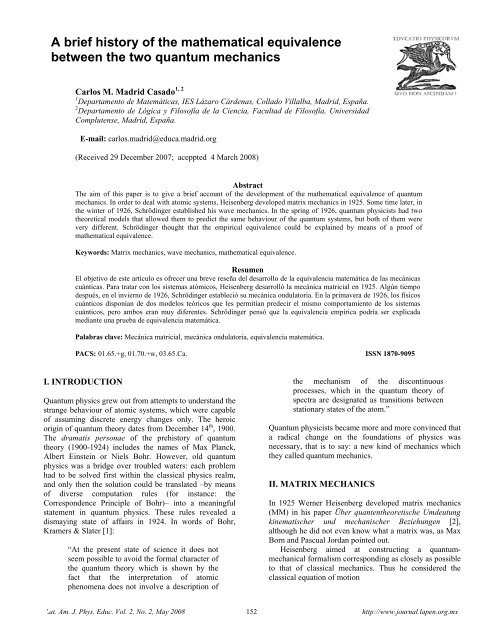
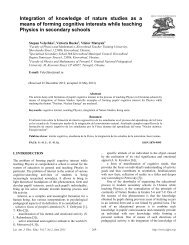
![Diversas formas de visualizar estados en un sistema cuántico [PDF]](https://img.yumpu.com/51151303/1/190x245/diversas-formas-de-visualizar-estados-en-un-sistema-cuantico-pdf.jpg?quality=85)

![Precession and nutation visualized [PDF]](https://img.yumpu.com/50786044/1/190x245/precession-and-nutation-visualized-pdf.jpg?quality=85)
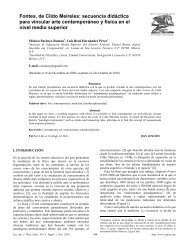
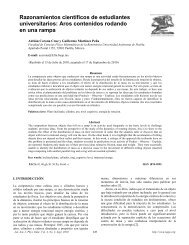

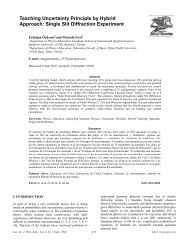
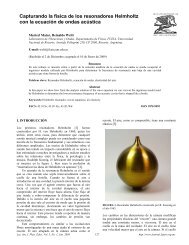
![Index [PDF] - Latin-American Journal of Physics Education](https://img.yumpu.com/47984121/1/190x245/index-pdf-latin-american-journal-of-physics-education.jpg?quality=85)
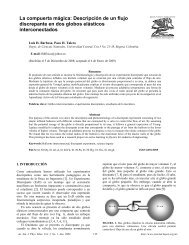
![Flujo de agua en botellas como experimento didáctico [PDF]](https://img.yumpu.com/43536300/1/190x245/flujo-de-agua-en-botellas-como-experimento-didactico-pdf.jpg?quality=85)
